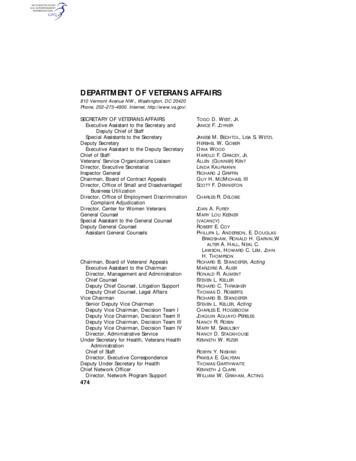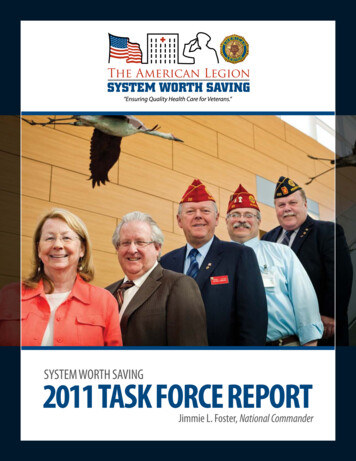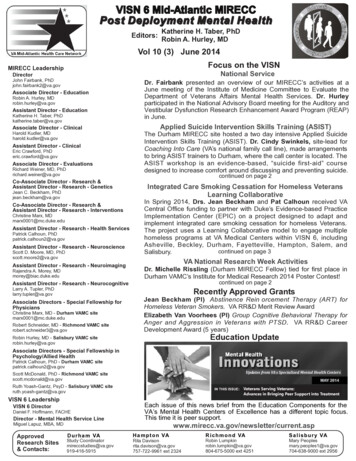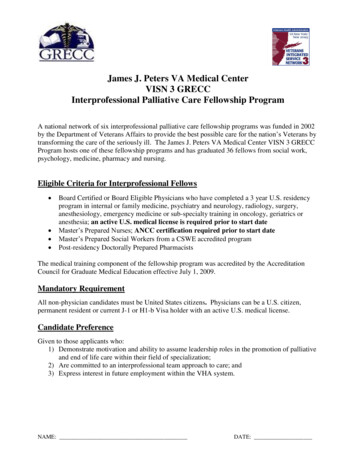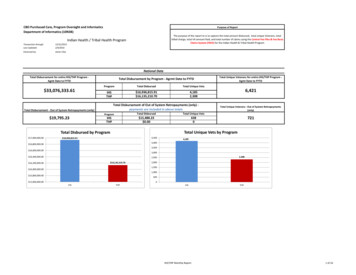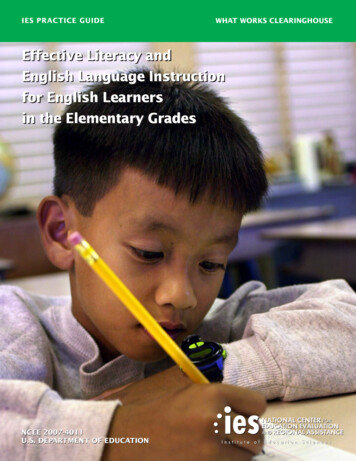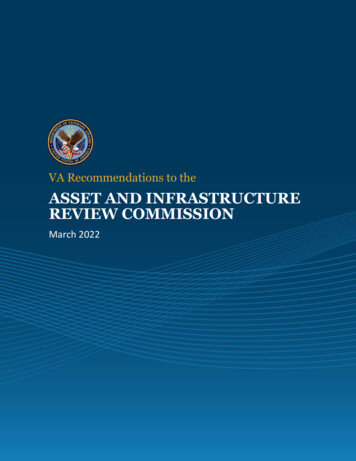
Transcription
VISNVolume II:MarketRecommendationsVA Recommendations to theASSET AND INFRASTRUCTUREREVIEW COMMISSIONMarch 2022Volume II: Market Recommendations1va.gov/AIRCommissionReport
VISNVISN 22Market RecommendationsVolume II: Market Recommendationsva.gov/AIRCommissionReport2
Table of ContentsVISN 22 Loma Linda Market . 4VISN 22 San Diego Market . 14VISN 22 Greater Los Angeles Market . 25VISN 22 Albuquerque Market . 38VISN 22 Tucson Market . 49VISN 22 Prescott Market . 60VISN 22 Phoenix Market . 70Volume II: Market Recommendationsva.gov/AIRCommissionReport3
VISN 22 Loma Linda MarketVISN 22 Loma Linda MarketThe Veterans Integrated Service Network (VISN) 22 Loma Linda Market serves Veterans in southernCalifornia, east of Los Angeles in Riverside, San Bernardino, and Inyo counties. The recommendationincludes justification for the proposed action, the results of the cost benefit analysis, and an overview ofhow the market recommendation is consistent with the MISSION Act Section 203 selection criteria. 1VA’s Commitment to Veterans in the Loma Linda MarketThe Department of Veterans Affairs (VA) is committed to providing equitable Veteran access to safe andhigh-quality care and services in VISN 22’s Loma Linda Market. We will operate a high-performingintegrated delivery network that provides access to VA care, supplemented by care provided by Federalpartners, academic affiliates, and community providers.Based on substantial data analysis, interviews with VISN and VA medical center (VAMC) leaders,consultation with senior VA leadership, and the input received from Veterans and stakeholders, VA hasdeveloped a recommendation designed to ensure that Veterans today and for generations to come haveaccess to the high-quality care they have earned. The recommendation also makes sure that VAcontinues to execute on its additional missions: education and training, research, and emergencypreparedness. As VA considers implementing any recommendation approved by the Asset andInfrastructure Review (AIR) Commission, implementation will be carefully sequenced so that facilities orpartnerships to which care will be realigned are fully established before the proposed realignmentoccurs.Market StrategyThe market is facing low enrollment growth. Demand for inpatient medical and surgical servicesis decreasing, while demand for inpatient mental health, long-term care, and outpatient care isincreasing. Many outpatient facilities in the market are contracted sites of care, which will betransitioned to VA-leased facilities with care delivered by VA providers. The strategy for the market isintended to provide Veterans with access to high-quality and conveniently located care in moderninfrastructure. Key elements of the strategy are described below: Provide equitable access to outpatient care through modern facilities close to where Veteranslive and through the integration of virtual care: VA’s recommendation invests in modernizedoutpatient sites offering primary care, mental health, and low acuity specialty services to betterdistribute care. The recommendation expands three community-based outpatient clinics(CBOCs) in Murrieta, Palm Desert, and Rancho Cucamonga to multi-specialty community-basedoutpatient clinics (MS CBOCs) to enhance Veteran access. The recommendation also transitionscare from contracted care to VA care in VA facilities at the Corona and Victorville CBOCs.Please see the Volume II Reading Guide for more information concerning the purpose of each MarketRecommendation section and key definitions.1Volume II: Market Recommendationsva.gov/AIRCommissionReport4
VISN 22 Loma Linda Market Enhance VA’s unique strengths in caring for Veterans with complex needs: VA’srecommendation establishes a new stand-alone residential rehabilitation treatment program(RRTP) to provide comprehensive care that may not be readily available in the community andenhances geropsychiatry services in a new unit at the community living center (CLC). Therecommendation maintains inpatient mental health programs at the Loma Linda VAMC. TheLong Beach VAMC in the Greater Los Angeles Market is the inpatient spinal cord injuries anddisorders (SCI/D) specialty hub for the Loma Linda Market. Demand for inpatient blindrehabilitation services will be met at the Long Beach, California VAMC (VISN 22). Provide equitable access to quality inpatient medical and surgical care through the optimizeduse of care delivered in VA facilities and through partnerships, community providers, andvirtual care: VA’s recommendation modernizes inpatient medical and surgical services withinthe Loma Linda VAMC to provide high-quality inpatient medical and surgical care.Market OverviewThe market overview includes a map of the Loma Linda Market, key metrics for the market, and selectconsiderations used in forming the market recommendation.Market MapNote: A partnership is a strategic collaboration between VA and a non-VA entity.Volume II: Market Recommendationsva.gov/AIRCommissionReport5
VISN 22 Loma Linda MarketFacilities: The market has one VAMC (Loma Linda), one MS CBOC, five CBOCs, and one other outpatientservices (OOS) site.Enrollees: In fiscal year (FY) 2019, the market had 105,290 enrollees and is projected to experience a1.9% increase in enrolled Veterans by FY 2029. The market covers three counties in California, and thelargest enrollee populations are in the counties of Riverside and San Bernardino, California.Demand: Demand 2 in the market for inpatient medical and surgical services is projected to decrease by8.6% and demand for inpatient mental health services is projected to increase by 4.2% between FY 2019and FY 2029. Demand for long-term care 3 is projected to increase by 41.5%. Demand for all outpatientservices, 4 including primary care, mental health, specialty care, dental care, and rehabilitation therapies,is projected to increase.Rurality: 11.9% of enrollees in the market live in rural areas compared to the VA national average of32.5%.Access: 88.2% of enrollees in the market live within a 30-minute drive time of a VA primary care site and86.5% of enrollees live within a 60-minute drive time of a VA secondary care site.Community Capacity: As of 2019, community providers 5 in the market within a 60-minute drive time ofthe VAMC had an inpatient acute occupancy rate 6 of 58.5% (2,371 available beds) 7 and an inpatientmental health occupancy rate of 75.6% (33 available beds). Community nursing homes within a 30minute drive time of the VAMC were operating at an occupancy rate of 91.0% (51 available beds),indicating limited community capacity. Community residential rehabilitation programs 8 that match thebreadth of services provided by VA are not widely available in the market.Mission: VA has academic affiliations in the market that include Loma Linda University and theUniversity of California, Riverside. The Loma Linda VAMC is ranked 21 out of 154 VA training sites basedon number of trainees and is ranked 57 out of 103 VAMCs with research funding. The Loma Linda VAMChas no emergency designation. 9Projected market demand for inpatient medical and surgical services is based on VA’s Enrollee Health CareProjection Model (EHCPM) in bed days of care (BDOC).3Projected market demand for inpatient Long-Term Services and Supports (LTSS) is based on VA’s EHCPM in BDOC.4Projected market demand for outpatient services is based on VA’s EHCPM in relative value units (RVUs).5Community providers include Veterans Community Care Program (VCCP) providers and potential VCCP providers.6Occupancy rates are calculated by dividing the total average daily census (ADC) by the total number of operatingbeds. Beds at hospitals or nursing homes above the target occupancy rates are excluded.7Available beds in the community are estimated using a target occupancy rate of 80% for hospitals and 90% forcommunity nursing homes.8Includes community residential rehabilitation programs similar to VA's RRTP, blind rehabilitation, andrehabilitative SCI/D services.9VAMCs participating in the National Disaster Medical System are designated as Federal Coordinating Centers.Select Federal Coordinating Centers are also designated as Primary Receiving Centers.2Volume II: Market Recommendationsva.gov/AIRCommissionReport6
VISN 22 Loma Linda MarketFacility OverviewLoma Linda VAMC: The Loma Linda VAMC is located in Loma Linda, California, and offers inpatientmedical and surgical, inpatient mental health, CLC, and outpatient services. In FY 2019, the Loma LindaVAMC had an inpatient medical and surgical average daily census (ADC) of 72.3, an inpatient mentalhealth ADC of 18.8, and a CLC ADC of 66.2.The Loma Linda VAMC was built in 1977 on a 40.0-acre campus. The last major renovation was in 1985.Zero acres are available for additional development, and the facility is undergoing unit renovations toprovide private patient rooms. Facility condition assessment (FCA) deficiencies are approximately 113.8M, and annual operations and maintenance costs are an estimated 16.2M.Recommendation and JustificationThis section details the VISN 22 Loma Linda Market recommendation and justification for each elementof the recommendation.Future Market MapVolume II: Market Recommendationsva.gov/AIRCommissionReport7
VISN 22 Loma Linda Market1. Modernize and realign the Loma Linda VAMC by modernizing the inpatient medical and surgicalunits at the Loma Linda VAMC: In FY 2019, the Loma Linda VAMC had 132 inpatient medical andsurgical beds with an ADC of 72.3. Between FY 2019 and FY 2029, inpatient medical and surgical inhouse demand is projected to decrease from an ADC of 72.3 to an ADC of 59.7. Converting existingshared rooms to private patient rooms will increase privacy, improve patient satisfaction, and bringcare delivery up to modern health care standards. In addition, decreasing beds to 76 willappropriately accommodate projected demand.2. Modernize by establishing a new stand-alone RRTP in the vicinity of Loma Linda, California: TheLoma Linda Market currently does not have an RRTP and primarily uses the West Los Angeles andSan Diego VAMCs for services. Projected demand and convenient access to residential rehabilitationservices are the major drivers for the recommendation to establish an RRTP in the market. Themarket has a projected FY 2028 RRTP bed demand of 60. In FY 2019, there were 96,309 enrolleeswithin 60 minutes of the proposed stand-alone RRTP site. The new RRTP will reduce out-of-markettravel, allow Veterans to receive residential rehabilitation closer to where they live, and create asustainable program. The San Diego VAMC’s Aspire Center, where intensive treatment for posttraumatic stress disorder (PTSD) is the sole focus, will be the designated location for PTSD servicesfor the Loma Linda Market.3. Modernize and realign outpatient facilities in the market by:3.1. Relocating the Murrieta CBOC to a new site in the vicinity of Murrieta, California, and closingthe Murrieta CBOC: In FY 2019, the Murrieta CBOC served 8,676 core uniques 10 at the existingsite. There were 108,293 enrollees within 60 minutes and 24,136 enrollees within 30 minutesof the CBOC in FY 2019. Additionally, Riverside County, where the Murrieta CBOC is located, isprojected to experience a 5.6% increase in enrollment between FY 2019 and FY 2029. Replacingthis contracted facility with a VA-staffed and leased facility in the vicinity of Murrieta,California, will allow for improved access to outpatient services and improved Veteransatisfaction through more appropriately maintained staffing levels, accommodations forpatient-aligned care teams (PACTs), and the addition of specialty services, which will classifythis site as an MS CBOC.3.2. Relocating the Palm Desert CBOC to a new site in the vicinity of Palm Desert, California, andclosing the Palm Desert CBOC: In FY 2019, the Palm Desert CBOC served 8,902 core uniques atthe existing site. There were 30,555 enrollees within 60 minutes and 9,562 enrollees within 30minutes of the CBOC in FY 2019. Additionally, Riverside County, where the Palm Desert CBOC islocated, is projected to experience a 5.6% increase in enrollment between FY 2019 and FY2029. Replacing this contracted facility with a VA-staffed and leased facility in the vicinity ofPalm Desert, California, will allow for improved access to outpatient services and improvedVeteran satisfaction through more appropriately maintained staffing levels, accommodationsfor PACT teams, and the addition of specialty services, which will classify this site as an MSCBOC.VA core unique patients exclude Veterans who have used only VA telephone triage, pharmacy, and laboratoryservices.10Volume II: Market Recommendationsva.gov/AIRCommissionReport8
VISN 22 Loma Linda Market3.3. Relocating the Rancho Cucamonga CBOC to a new site in the vicinity of Rancho Cucamonga,California, and closing the Rancho Cucamonga CBOC: In FY 2019, the Rancho Cucamonga CBOCserved 7,342 core uniques. There were 113,725 enrollees within 60 minutes and 34,605enrollees within 30 minutes of the CBOC in FY 2019. Additionally, San Bernardino County,where the Rancho Cucamonga CBOC is located, enrollment is projected to slightly decrease by2.8% from 45,268 in FY 2019 to 44,015 in FY 2019. Replacing this contracted facility with a VAstaffed and leased facility in the vicinity of Rancho Cucamonga, California, will allow forimproved access to outpatient services and improved Veteran satisfaction through moreappropriately maintained staffing levels, accommodations for PACT teams, and the addition ofspecialty services, which will classify this site as an MS CBOC.3.4. Relocating the Corona CBOC to a new site in the vicinity of Corona, California, and closing theCorona CBOC: In FY 2019, the Corona CBOC served 3,914 core uniques and had 24,590enrollees within 30 minutes of the CBOC. Additionally, Riverside County, where the CoronaCBOC is located, is projected to experience a 5.6% increase in enrollment between FY 2019 andFY 2029. Replacing this contracted facility with a VA-staffed and leased facility in the vicinity ofCorona, California will allow for improved access to outpatient services and improved Veteransatisfaction through more appropriately maintained staffing levels and accommodations forPACT teams.3.5. Relocating the Victorville CBOC to a new site in the vicinity of Victorville, California, andclosing the Victorville CBOC: In FY 2019, the Victorville CBOC served 5,675 core uniques andhad 10,896 enrollees within 30 minutes of the CBOC. Additionally, San Bernardino County,where the Victorville CBOC is located, enrollment is projected to slightly decrease by 2.8% from45,28 in FY 2019 to 44,015 in FY 2029. Replacing this contracted facility with a VA-staffed andleased facility in the vicinity of Victorville, California, will allow for improved access tooutpatient services and improved Veteran satisfaction through more appropriately maintainedstaffing levels and accommodations for PACT teams.Complementary StrategyIn addition to the recommendation submitted for AIR Commission approval, VA also anticipatesimplementing a complementary strategy that supports a high-performing integrated delivery network:Loma Linda Market Realign Inyo County, California, from the VISN 22 Loma Linda Market to the VISN 21 SierraNevada Market: Referral patterns indicate that Veterans from Inyo County in VISN 22 arealready traveling to VISN 21 to receive care. Realigning Inyo County to VISN 21 will moreaccurately reflect the patterns by which Veterans seek care and have minimal impact on theLoma Linda Market.Volume II: Market Recommendationsva.gov/AIRCommissionReport9
VISN 22 Loma Linda MarketLoma Linda VAMC Establish a new dedicated geropsychiatric unit within the CLC at the Loma Linda VAMC (SanBernardino County) (in progress): The addition of a geropsychiatric unit will address an unmetneed for these specialized services in the market. Create strategic collaborations with the State Veterans Home and utilize community providersin Barstow, California, to meet the demand for long-term CLC services. Improve efficiency ofCLC services currently offered at the Loma Linda VAMC (San Bernardino County): As long-termcare demand is projected to increase, creating multiple community partnerships will enable theVAMC to accommodate more residents for long-term care. Improvement of occupancy in theCLC will help address a part of the demand and reduce reliance on nursing home care in thecommunity.Cost Benefit AnalysisThe Cost Benefit Analysis (CBA) evaluated the costs and benefits of three courses of action (COAs) forthe VISN 22 Loma Linda Market: Status Quo, Modernization, and VA Recommendation. Status Quoincludes costs associated with FCA deficiencies and represents no significant change in capital andoperational costs. Modernization seeks to modernize all existing health care infrastructure. The VARecommendation implements the market recommendation and seeks to modernize any remaininghealth care infrastructure. Costs: The present value cost 11 over a thirty-year period was calculated for each COA, inclusiveof capital and operational costs. The capital cost includes costs associated with construction ofnew facilities, modernization of current facilities, leases, land acquisition, and demolition. VAoperational cost includes direct costs (e.g., medical service costs), indirect costs (e.g.,administrative costs), and VA special direct costs (e.g., suicide prevention coordinators). Non-VAcare costs include direct costs (e.g., payments for patient care), indirect costs (e.g., carecoordination), overhead costs (e.g., national program costs), and administrative per member permonth costs (e.g., third party administration of the Community Care Network). Benefits: Benefits were evaluated based on five key domains: Demand and Supply, Access,Facilities and Sustainability, Quality, and Mission.The CBA leveraged both the costs and benefits to generate a Cost Benefit Index (CBI) – a simple metricused to compare the costs and benefits associated with each COA. The COA with the lowest CBI is thepreferred COA. The results of the CBA for the VISN 22 Loma Linda Market are provided in the followingtable. For more detailed information on the market CBA, please see Appendix H.11The present value cost is the current value of future costs discounted at the defined discount rate.Volume II: Market Recommendationsva.gov/AIRCommissionReport10
VISN 22 Loma Linda MarketVISN 22 Loma Linda MarketStatus QuoModernizationVA RecommendationTotal Cost 21,553,317,485 22,441,804,116 22,921,617,875Capital Cost 905,198,455 1,793,685,086 2,273,498,845Operational Cost 20,648,119,030 20,648,119,030 20,648,119,030Total Benefit ScoreCBI (normalized in B)911142.392.041.64Note: Operational costs are shifted from VA to non-VA care only when a service line is relocated intotality to non-VA care at the parent facility level. Total cost is a sum of operational and capital costsrounded to the nearest dollar.Section 203 Criteria AnalysisThis section provides an overview of how this market recommendation is consistent with the Section203 decision criteria as required by the MISSION Act. For more detailed information, please seeAppendix I.DemandThis recommendation is consistent with the Demand criterion, aligning VA's high-performing integrated deliverynetwork resources to effectively meet the future health care demand of the Veteran enrollee population with thecapacity in the market. Summary: Following implementation of the recommendation, the capacity available through VA facilitiesand community providers would be able to support 100% of the projected enrollee demand. Outpatient: Outpatient demand will be met through eight VA points of care offering outpatient services,including the proposed expanded Murrieta, California MS CBOC; Palm Desert, California MS CBOC; andRancho Cucamonga, California MS CBOC as well as community providers in the market. CLC: Long-term care demand will be met through the Loma Linda, California VAMC and the State VeteransHome in Barstow, California, as well as community nursing homes.The recommendation ensures that projected demand for SCI/D, RRTP, and blind rehabilitation is sufficiently metthrough VA-only capacity in the respective VISN or blind rehabilitation region. SCI/D: Demand for inpatient SCI/D will be met through the SCI/D Hub at the Long Beach, California VAMC(VISN 22). RRTP: RRTP demand will be met through the proposed new stand-alone RRTP in Loma Linda, California, andthe other facilities within VISN 22 offering RRTP, including the San Diego, California VAMC; the stand-aloneRRTP in San Diego, California; the West Los Angeles, California VAMC; the proposed new Anthem, ArizonaVAMC; the Prescott, Arizona VAMC; the Tucson, Arizona VAMC; and the RRTP at the Albuquerque, NewMexico VAMC. Blind rehabilitation: Inpatient blind rehabilitation demand will be met through the facilities in theSouthwest Region, including the Long Beach, California VAMC (VISN 22); the Tucson, Arizona VAMC (VISN22); the Biloxi, Mississippi VAMC (VISN 16); and the Waco, Texas VAMC (VISN 17).Volume II: Market Recommendationsva.gov/AIRCommissionReport11
VISN 22 Loma Linda MarketDemand Inpatient acute: Inpatient medicine, surgery, and mental health demand will be met through the LomaLinda, California VAMC, as well as through community providers.AccessThis recommendation is consistent with the Access criterion, maintaining or improving Veteran access to care inthe market and providing Veterans the opportunity to choose the care they trust throughout their lifetime. TheAccess criterion evaluates enrollee access to care in the current and proposed future state across multiple servicelines. It is evaluated for both the overall enrollee population as well as for specific subpopulations of enrolleesthat traditionally face barriers in receiving appropriate care, including minority enrollees, enrollees over 65,women enrollees, rural enrollees, and enrollees living in disadvantaged neighborhoods. Below are the accessresults for both primary care and specialty care among the overall enrollee population. Access to primary care: Following implementation of the recommendation, the number of enrollees within30 minutes of primary care available through VA facilities and community providers is projected to bemaintained, with 104,282 enrollees within 30 minutes of primary care in the future state. Access to specialty care: Following implementation of the recommendation, the number of Veterans within60 minutes of specialty care available through VA facilities and community providers is projected to bemaintained, with 104,838 enrollees within 60 minutes of specialty care in the future state.MissionThis recommendation is consistent with the Mission criterion, providing for VA’s second, third, and fourth healthrelated statutory missions of education, research, and emergency preparedness. Education: The recommendation for this market supports VA’s ability to maintain its education mission inVISN 22. The recommendation allows for continued relationships with key academic partners, including butnot limited to, the affiliation with Loma Linda University and the University of California at Riverside. Research: This recommendation does not impact its research mission in the market and allows the LomaLinda, California VAMC to maintain the current research mission. Emergency preparedness: This recommendation maintains VA’s ability to execute its emergencypreparedness mission; the Loma Linda, California VAMC is not designated as a Primary Receiving Center.Volume II: Market Recommendationsva.gov/AIRCommissionReport12
VISN 22 Loma Linda MarketQualityThis recommendation is consistent with the Quality criterion, considering the quality and delivery of health careservices available to Veterans in the market, including the experience, safety, and appropriateness of care. Quality among providers: The recommendation ensures that all providers included within the highperforming network meet the established quality standards by provider type (outlined in Appendix E). Quality improvements through new infrastructure: Quality is improved through the proposed new standalone RRTP in Loma Linda, California, as well as the modernization of the inpatient medical and surgicalrooms at the Loma Linda, California VAMC. This new infrastructure will aid in improving the patientexperience with care delivery provided in modern spaces and aid in the recruitment of staff with facilitiesoffering the latest technology. Promoting recruitment of top clinical and non-clinical talent: The recommendation maintains VA’sacademic and non-academic partnerships, which supports the recruitment and retention of top clinical andnon-clinical talent.Cost EffectivenessThis recommendation is consistent with the Cost Effectiveness criterion, providing a cost-effective means bywhich to provide Veterans with modern health care. The Cost Effectiveness criterion was assessed through a CBAsummarized in the CBA section and detailed in Appendix H. CBI: The CBI is the primary metric for cost effectiveness. The CBI for the VA Recommendation COA is lowerthan the Status Quo COA (1.64 for VA Recommendation versus 2.39 for Status Quo), indicating that the VARecommendation is more cost effective than the Status Quo.SustainabilityThis recommendation is consistent with the Sustainability criterion, creating a sustainable health care deliverysystem for Veterans. It ensures that the health care delivery system proposed for the market is aligned withfuture demand, allowing it to sustainably operate and provide a safe and welcoming health care environmentthat meets modern health care standards. Aligns investment in care and services with projected Veteran care needs: All facilities in the future stateof this market meet the minimum demand threshold to support sustainable services. Sustainability improvements through new infrastructure: Within this recommendation, sustainability isimproved through the proposed new stand-alone RRTP in Loma Linda, California, as well as themodernization of the inpatient medical and surgical rooms at the Loma Linda, California VAMC. This newinfrastructure modernizes VA facilities to include state-of-the-art equipment that will aid in the recruitmentof providers and support staff. Reflects stewardship of taxpayer dollars: While the cost of the market recommendation is more than thecost to modernize facilities in the market today ( 22.9B for VA Recommendation versus 22.4B forModernization), there are benefits realized through the market recommendation in at least one of the fivedomains assessed by the CBA that are not realized through the modernization approach. As a result, the CBIscore for the VA Recommendation COA is lower than the Modernization COA (1.64 for VA Recommendationversus 2.04 for Modernization), reflecting effective stewardship of taxpayer dollars.Volume II: Market Recommendationsva.gov/AIRCommissionReport13
VISN 22 San Diego MarketVISN 22 San Diego MarketThe Veterans Integrated Service Network (VISN) 22 San Diego Market serves Veterans in southernCalifornia. The recommendation includes justification for the proposed action, the results of the costbenefit analysis, and an overview of how the market recommendation is consistent with the MISSIONAct Section 203 selection criteria. 12VA’s Commitment to Veterans in the San Diego MarketThe Department of Veterans Affairs (VA) is committed to providing equitable Veteran access to safe andhigh-quality care and services in VISN 22’s San Diego Market. We will operate a high-performingintegrated delivery network that provides access to VA care, supplemented by care provided by Federalpartners, academic affiliates, and community providers.Based on substantial data analysis, interviews with VISN and VA medical center (VAMC) leaders,consultation with senior VA leadership, and the input received from Veterans and stakeholders, VA hasdeveloped a recommendation designed to ensure that Veterans today and for generations to come haveaccess to the high-quality care they have earned. The recommendation also makes sure that VAcontinues to execute on its additional missions: education and training, research, and emergencypreparedness. As VA considers implementing any recommendation approved by the Asset andInfrastructure Review (AIR) Commission, implementation will be carefully sequenced so that facilities orpartnerships to which care will be realigned are fully established before the proposed realignmentoccurs.Market StrategyThe market is facing moderate enrollment growth. Demand for inpatient medical and surgical servicesis declining while demand for inpatient mental health, long-term care, and outpatient care is increasing.Significant enrollment growth of women Veterans is projected. The San Diego VAMC will be modernized,and investments will be made to expand the community living center (CLC), residential rehabilitationtreatment program (RRTP), and outpatient services. The strategy for the market is intended to provideVeterans with access to high-quality and conveniently
the Loma Linda VAMC to provide high-quality inpatient medical and surgical care. Market Overview . The market overview includes a map of the Loma Linda Market, key metrics for the market, and select considerations used in forming the market recommendation. Market Map . Note: A partnership is a strategic collaboration between VA and a non-VA entity.
